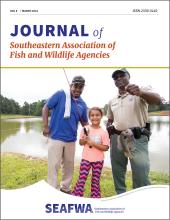Seasonal Food Habits and Prey Selectivity of Alligator Gar from Texoma Reservoir, Oklahoma
Alligator gar (Atractosteus spatula) were once viewed negatively by anglers and state agencies, but interest in reintroduction and trophy management of gar has increased in many states across their range, including Oklahoma. Therefore, the Oklahoma Department of Wildlife Conservation is planning to reintroduce alligator gar back into their native range. Thus, biologists decided to implement a food habits study to determine potential impacts of alligator gar to other fish populations in order to address angler concerns about possible reintroduction. The objectives of this study...
